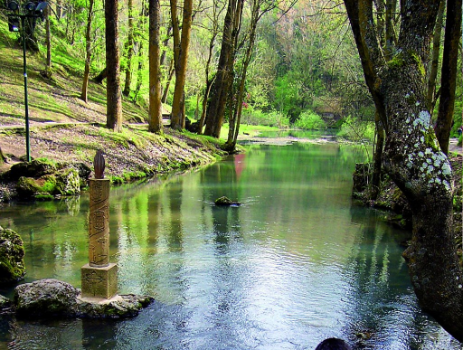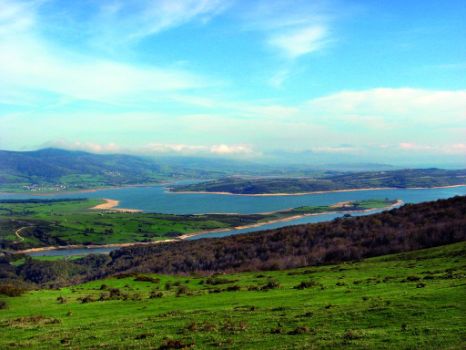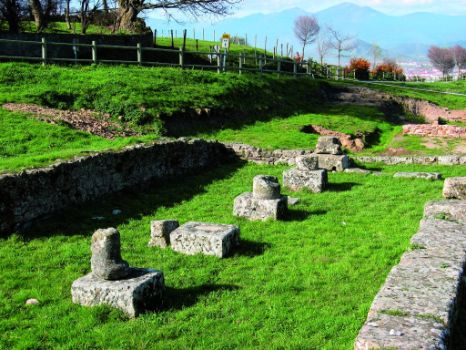Net of Natural
Trails

Stage 1: Fontibre - Montes Claros
Description
Fontibre (Fontes Iberis, i.e. headwaters of the Ebro), idyllic natural landscape at an altitude of 885 metres and birthplace of the most voluminous river in the Iberian Peninsula, is the trail head of the Ebro Nature Trail that winds towards the Mediterranean. The Trail starts at the headwaters of the Ebro, where an interpretation centre on the river may be visited. It first heads up a flagstone road to the CA-183, whence a pedestrian and bicycle path leads to Salces and Nestares, 1.4 km further on. Reinosa, situated next to the San Francisco retirement home, may be visited (5.2 km, 1hr 5min).

From here, the GR ventures into the park that runs parallel to the Ebro along the right bank. Shortly after Marqués de Reinosa Street, it crosses Carlos III Avenue over the namesake bridge, along the same riverbank, until it passes the green zone next to a level crossing.
On the opposite side, the route continues along the river, past railroad bridges and the N-611, towards Requejo. Further on, 1.5 km down the road, it reaches Bolmir and its 13th century Romanesque church of San Ciprián. The Ebro Nature Trail crosses the road to Arroyo and climbs through the countryside towards Retortillo, where the 12th century Romanesque church of Santa Maria can be seen, as well as the Roman city of Julióbriga and its visitors' centre (9.3 km, 2hr 10min).
South of the village, past a gate and track, and leaving a water tank to the left and the cemetery to the right, the route arrives at El Apartadero and Camporredondo. Here, to the left, starts a path that leads to the summit of El Cotío, (1,163 m, 12.8 km, 3hr 25min), which is only one kilometre from Peña Cutral (1,085 m).

The views from here are stunning - Peña Labra (2,017 m), Pico Tres Mares (2,222 m), Reinosa, the reservoir and the meandering Ebro. In the distance are the “pasiego” mountains, including Castro Valnera (1,718 m) and Picón del Fraile (1,648 m). To the south, towards Valderredible and Castilla, lies a vast open space.
From here, the route continues along the ridge, through a lush summer pasture, towards El Arroyo Hill (1,126 m). Past Peñastrosa, the route descends towards Arroyo (17.6 km, 4hr 55min), and continues along the road that crosses the town, amidst 19th century (glass factory) and 20th century (Ebro Reservoir) constructions.
Past the reservoir, an old road climbs towards La Aguilera, through a dense oak forest. Leaving behind the Romanesque church of San Miguel (outside the town), the route turns onto a road leaving Arroyo. Past the last few houses, a dirt road heads to a gate (on the right) that gives access to a farm. The Trail descends through fields of grasslands, overlooking Sierra de Peña Labra and the Ebro (to the west).

The path reaches a firebreak, along which it climbs down to cross Morgado Brook, and then heads up again. Further on, the route turns right (south) along a trail that descends through pastures and pine forests, and crosses the Tasugueras Brook, towards Bustasur (23.7 km, 6hr 40min). Once back on the road, the route continues left, past the 12th century Romanesque church of San Julián, then veers onto a track to the right that climbs down to the bridge over the Ebro.
After crossing the bridge, the route climbs along the uphill path to the right, through a dense oak forest, then continues along a track to the right (west), leading to the railway stop of Montes Claros. A paved lane leads to the Monastery of Montes Claros, (970 m, 26.6 km, 7hr 35min). The monastery has an inn (open May to October), a bar and a museum with a notable collection of butterflies.
Sites of interest
Puntos de interés
Culture
Hydrography
Infrastructure
Municipality
Profile






